
IRIS login | Reed College home Volume 93, No. 1: March 2014
Thinker. Tailor. Soldier. Spy.
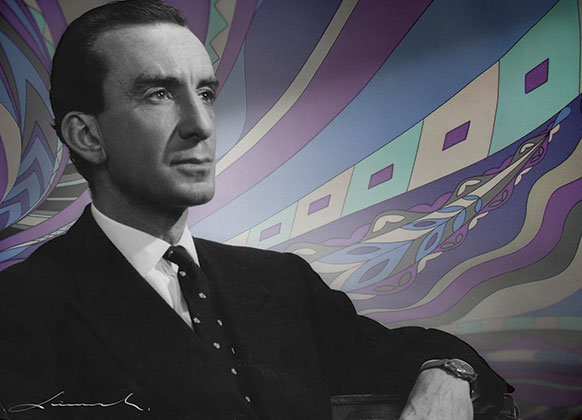
The kaleidoscopic career of designer Emilio Pucci MA ’37.
By Raymond Rendleman ’06
It was the last straw.
All semester long, the freshmen had put up with his exotic accent. His fancy footwork on the dance floor. His Florentine flamboyance and the way the women swooned over him.
Now Emilio Pucci MA ’37 had pushed their patience to the limit. To show off the new uniforms he had designed for the Reed ski team, he built a wooden ramp in the canyon, coated it with soap to make it slick—and invited a news crew to film the Reed skiers in their sleek outfits.
So the freshmen reckoned it was time to grab a little glory of their own. When the news crews arrived, Gregg Wood ’39 and three other classmates stripped off their clothes and jumped naked into the outdoor swimming pool that sat below the lake. “We went down to the canyon swimming pool and broke the ice that was about an inch thick,” said Gregg, a member of Reed’s dance committee that Emilio’s showmanship always overshadowed. “It just ended up being as cold as heck, so we ran back to the gym for hot showers.”
Unfortunately, the stunt came to naught. The newsmen shrugged and trained their cameras on the skiers. Emilio was, as usual, the man of the hour, and the envy he aroused only seemed to deepen his mystique. It was as if he were destined to hog the spotlight—a fitting talent for a man who would eventually become a world-class fashion designer. But Emilio was more than that. His story also slaloms through some imposing philosophical moguls. Throughout his long and productive life, he struggled to reconcile diametrically opposed ideas: his youthful infatuation with fascism with his belief in freedom and opportunity; his loyalty to his homeland and his love of his adopted country; his distrust of materialism while embracing an inherently materialistic medium. What he managed in his lifelong quest was nothing short of astonishing: He predicted—and designed for—a future in which everyone would have to negotiate their own such opposing forces.
Penniless Aristocrat
Emilio’s home address was Pucci Palace, built for his family nearly 1,000 years ago. Heir to one of Italy’s oldest noble families, his full name was Emilio Paolo Pucci dei Marchese di Barsento, referring to the family’s fiefdom on the Adriatic Sea. Pucci Palace still contains a Botticelli painting showing the use of forks, by legend adopted for the first time in Florence by the Pucci family. After Catherine de’ Medici used a fork, the fad spread across Europe.
In some ways, this fairy-tale legacy suited Emilio. He was an accomplished athlete and expert skier who represented Italy in the 1932 Winter Olympics at Lake Placid. But there was also a questing, iconoclastic part of his personality. He felt stifled by the snobbish conventions of the Italian aristocracy and bored by his classes at the University of Milan. In 1935, he traveled halfway around the world and enrolled at the University of Georgia, where he studied cotton agriculture. But the environment didn’t provide the intellectual inspiration he was looking for. Worse, he found himself cut off from his family’s bank accounts as a result of the growing chaos in Europe. Emilio sought refuge in skiing and went on a trip to the slopes of Mount Hood. On his way back, he stopped at the office of Dexter Keezer [president 1934–42] in September 1936 to ask for help.
It was, to say the least, an unlikely meeting. Emilio was an old-money Italian aristocrat who was suddenly broke. Keezer was a self-made man from Massachusetts, a World War I veteran, former reporter, economist, and New Deal Democrat. On top of that, they could have guessed that their countries had a strong chance of opposing each other in war. Their meeting came as Italy and Germany were shoring up their military alliance and right after the sinister 1936 Berlin Olympics.
Emilio’s problem was simple. Despite his aristocratic pedigree, he lacked ready funds for his education due to Italian exchange restrictions stemming from its war with Ethiopia. He wanted to study at Reed because he had been told it was “a very good college.” Moreover, Emilio said, he wanted to see if he could make his own way in the U.S. after being forbidden even to take a walk alone for years in Italy, where a servant accompanied him everywhere.
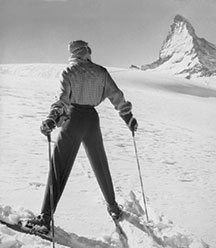
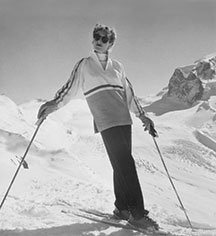
SLEEK PROFILE: Pucci hit the big time when Harper’s Bazaar ran a spread of stylish skiers modelling his clothes on the slopes of Zermatt in 1948. Photos by Toni Frissell
The two men struck a deal. According to President Keezer’s own notes, available in the Hauser Library archives, Reed would provide Emilio with tuition, room, and board. In return, Emilio would form and coach Reed’s first ski team.
“His academic performance was first rate,” Keezer wrote of Emilio. “And so was the zest and goodwill with which he tackled a variety of lowly chores on the campus—waiting on tables, washing dishes, scrubbing—to acquire a bit of cash to supplement the bare subsistence being provided to him.”
Emilio’s panache persists as the strongest memory among his surviving classmates. Before World War II, Reed students mostly hailed from the Pacific Northwest, so the dashing Italian turned heads every time he walked into the Commons. Emilio’s roommate in Winch, Bob Scharf ’39, remembers him saying one evening, “A moonlit night like this is made for love,” before slipping out on some nocturnal adventure. Lee Canfield ’36, although acknowledging that his memory sometimes fails him at 98, remembers Emilio as “an engaging presence around campus who was involved in a number of activities.” With his usual flair, he drew a distinctive double griffin that still appears on Reed T-shirts and decals.
Carleton Whitehead ’41 [administrator, 1952–83] recalled Emilio as “a social animal” who cut a wide swath on campus. “You could tell, because some women were just delighted to see him again and others wouldn’t come within 10 feet of him.”
Kathleen Cahill Dougall ’37 remembers him as “very handsome and known for dancing the tango.” By many other current accounts, his most frequent dancing partner was Carolyn Bilderback ’38. Elizabeth McCracken McDowell ’34 remembers dancing with him once after he taught a group in the Winch social room the Viennese waltz.
Hanging out with Emilio required some fancy ideological footwork because he was also a passionate defender of Italian fascism, a fact often forgotten or omitted from romantic accounts. His thesis, written under his adviser, Prof. Tom Staveley [history 1924–25, 1936–37], was “Fascism: An Explanation and Justification.” Reading the text (available in the thesis tower) turns one’s stomach. Emilio wrote in the introduction that he meant his description of Italy’s governmental system to correct misunderstandings and promote world peace. He believed that a strong centralized government was essential to a prosperous modern society. President Keezer, who himself frequently spoke out against fascism, wrote later that he thought Emilio’s presence at Reed as a “vigorous champion of it, could enliven our campus in an intellectually stimulating way.”
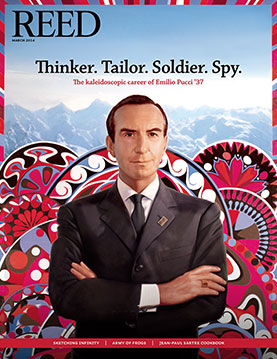
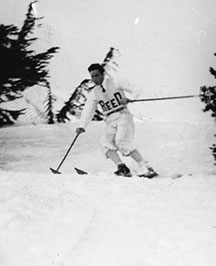
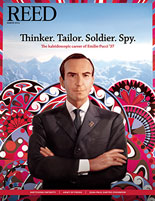
LATEST COMMENTS
steve-jobs-1976 I knew Steve Jobs when he was on the second floor of Quincy. (Fall...
Utnapishtim - 2 weeks ago
Prof. Mason Drukman [political science 1964–70] This is gold, pure gold. God bless, Prof. Drukman.
puredog - 1 month ago
virginia-davis-1965 Such a good friend & compatriot in the day of Satyricon...
czarchasm - 4 months ago
John Peara Baba 1990 John died of a broken heart from losing his mom and then his...
kodachrome - 7 months ago
Carol Sawyer 1962 Who wrote this obit? I'm writing something about Carol Sawyer...
MsLaurie Pepper - 8 months ago
William W. Wissman MAT 1969 ...and THREE sisters. Sabra, the oldest, Mary, the middle, and...
riclf - 10 months ago